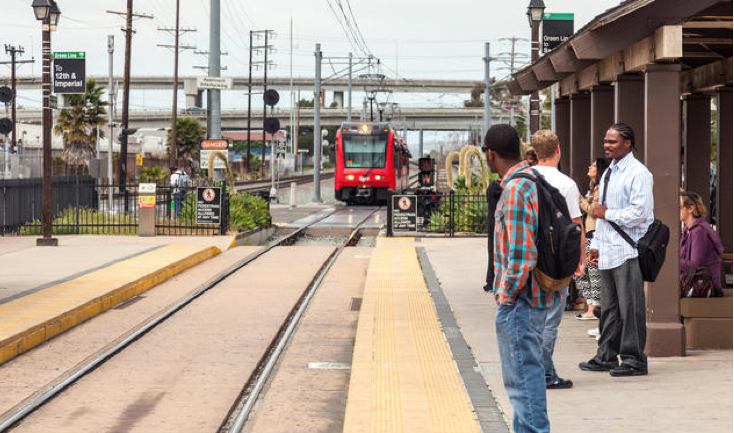CommentsPERSPECTIVE--There once was a time in America when people of means weren’t keen on the idea of living right next to a rail station. Real estate developers, as a general matter, didn’t throw lots of capital into these communities, many of which quite literally defined the proverbial “other side of the tracks.”
Things have changed. Transit-oriented development, once little more than a jargony buzz phrase uttered by urban planners and public transportation advocates, is transforming cities and suburbs all across the country as the market for housing near transit hubs continues to explode.
Unfortunately, this type of development is also changing the affordability of long-standing communities that working-class residents have called home for generations. At issue is something called transit-induced gentrification, a socioeconomic by-product of transit-oriented development that would have been largely unthinkable 25 years ago, when the idea of living above a busy train station and not owning a car held less appeal among the upwardly mobile than it does today.
These same upwardly mobile workers, disproportionately young and college educated, are increasingly citing access to a variety of transportation options—including subways, light rail, bus rapid transit, and pedestrian and bicycle paths—as a determining factor when they’re choosing where to live. Many of them are abandoning automobile ownershipaltogether; they’d rather take the money they would spend on a car and insurance payments and spend it instead on a nice apartment within walking, biking, or railing distance to shops, restaurants, bars, gyms, and the office.
In response, developers, often working in close coordination with cities, have been building mixed-use projects near transit hubs at unprecedented rates. From a climate perspective, such location-efficient development is highly welcome, as it translates into fewer and/or shorter car trips for commuting and everyday errands, which in turn translates into fewer carbon emissions. From an economic perspective, it’s also quite a boon, not just for cities, which can reap massive tax revenues from new development, but also for individuals who—liberated from their cars—can watch as their transportation costs go down considerably. (Transportation is routinely listed as the third-largest household expense in America, after housing and food.)
But as developers race one another to erect fancy apartment buildings and condominiums that cater mainly to young professionals, longtime residents of neighborhoods adjacent to established or newly planned transit hubs are increasingly finding themselves priced out of their own communities. And the problem is getting big enough that urban planners and local governments are committing themselves to doing something about it.
In California, we can see how transit-induced gentrification works. One study recently conducted by the San Diego Union-Tribune looked at urban areas statewide (San Diego, Los Angeles, Sacramento, and the San Francisco Bay Area) and found that over the past five years, nearly 400 new multifamily buildings had either gone up or were under construction within half a mile of a transit stop. Median family income in these neighborhoods averaged less than $64,000. The average monthly rent for a two-bedroom apartment, meanwhile, was more than $3,500. And in nearly 20 percent of these neighborhoods, the median household income was less than $30,000—but the average rent on a two-bedroom apartment was still more than $3,300. That, suffice it to say, is an untenable situation for the average renter and a recipe for displacement.
Concerns about transit-induced gentrification are mounting everywhere that cities are expanding or improving their mass-transportation systems, especially their rail lines. In Maryland’s D.C. suburbs, planners and city officials are currently trying to square one of their original goals for the new Purple Line—dramatically easing lengthy commutes for members of working-class communities—with the sudden appearance of $1.5 million luxury townhomes next to planned stations, developments that excitedly advertise walking distance to trains in their pitches to prospective buyers. Similar tensions are playing out at the moment in Chicago, Atlanta, and Portland.
Some organizers and activists, channeling the fear and rage within their communities, have taken to protesting not only specific transit-oriented development projects but the concept as a whole. That’s understandable. But it also seems woefully shortsighted. Done right, this type of development can revitalize cities while demonstrably curbing carbon pollution by lowering automobile use. The key is in balancing these social goods with the good that comes from keeping existing communities healthy and intact—even as we set about building new ones.
So how, you ask, is transit-oriented development “done right”? It’s done right when municipalities and other governing bodies take formal steps to pair any new development with real affordable-housing protections. Many cities already require that developers set aside a number of their newly built units to be rented or sold at below-market rates. That’s a good start, but it’s not enough to evade the gentrification juggernaut.
We should also be exploring and implementing other policy-based strategies, such as those proffered by transportation economist Michael Ryan. These include allocating HUD-sponsored low-income housing tax credits to developers whose projects meet certain criteria, creating special “housing protection districts” guaranteeing that no unit of affordable housing will be knocked down without another going up in its place, and establishing dedicated funds that are designed to help developers finance land acquisition but are also tied to the promise of affordable-housing creation.
Transit-oriented development is a worthy pursuit and investment, with the potential to benefit everyone. But if it ignores the needs and realities of the working class and the economically marginalized—the two communities that need and use mass transit the most—it’s leaving people behind.
(onEarth provides reporting and analysis about environmental science, policy, and culture. All opinions expressed are those of the authors and do not necessarily reflect the policies or positions of NRDC. Learn more or follow them on Facebook and Twitter.
















